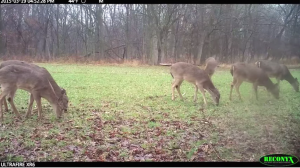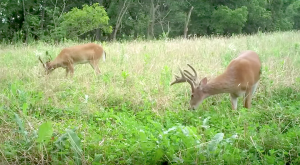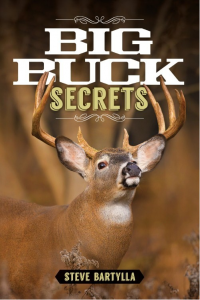Food Plots That Will Continue to Grow Into December

It was supposed to be the year I finally had the food plots right. Entering my second season managing the property, I planned to make up for my late start the previous year. With a deer population well above goal, I desperately needed to maximize the food production in my plots.
I failed, at least partially so. From July 2011 through January 2013, each month's total rainfall was well below average. In fact, it wasn't even close. The subsoil moisture wasn't low. It was nonexistent. Going into Fall 2012, with all the farmer's grain crops being near total failure, the situation was bleak.
It took every trick I've learned in more than 20 years of food plotting to produce nutrition-supplying food plots that fall. Even then, most new plantings were marginal.
There was one exception: the Antler King Trophy Clover plots I'd frost-seeded in February 2012. They were thriving, despite enduring the drought. In fact, they looked as strong as any second-year clover planting I've ever had, even though they were in their first year, which is generally less productive.
In fact, their production was so strong they were enough to save my bacon and provide an adequate level of nutrition through summer and fall. Just as important, the seed blend contains rape as a cover crop. Its robust growth provided a critical level of overwinter nutrition.
In deer and habitat management, turning over the soil in late fall or early winter is akin to a mortal sin. That's a shame. Sure, it's rarely the best practice to plow under food, leaving exposed dirt for months in its place. However, there are situations when it's the best course of action.
Late-fall and early-winter soil turning can be a good move. The trick is understanding when it's a positive and when it does more harm than good.

Benefits of Pre-Spring Soil Turning
Many of the advantages of late- fall and winter soil prep can be seen in the aforementioned Antler King Trophy Clover plots. When done properly, early efforts help provide an insurance policy against spring, summer and fall droughts.
The steps were simple. In that case, the property is in west-central Illinois. That's important to timing, as the relatively mild winters of that area allowed field work in mid- January. In points farther north, you must perform these tasks earlier to beat the frozen ground.
In either case, the critical first step is taken several months earlier. Collecting a spoonful of topsoil from equally distributed locations, providing a sandwich bag full of dirt that accurately represents soil quality, gives you time to submit the soil to a co-op, federal, state or county soils agency to have a soils test conducted. You then know the precise amount of lime and fertilizers required to produce a thriving plot.
Doing so lets you work in the lime and fertilizers before planting. That offers advantages and disadvantages.
The most obvious advantage is that all that work provides a head start on spring plot tasks. Simply, every step taken in winter is one less step to take in spring. That can be critical, when spring rains delay plantings or you have too much plot work that needs to be done at once.
Next, it gives the lime time to affect the soil. Lime does not provide an immediate fix. Instead, it requires time to break down into a difference-making state. The repeated freezing and thawing provides that head start and lets the lime immediately start benefiting the planting's new growth in spring.
Additionally, early working of compacted soils — a problem with many repeatedly worked and unhealthy soils — lets the soils collect and hold more winter and spring moisture, minimizing runoff. This is further encouraged when frost-seeded plots create moisture-saving canopies earlier than traditionally planted spring plots.
Finally, assuming the plant- ing can be and is effectively frost- seeded, it provides the planting itself a head start. With new seedlings emerging as early conditions allow, they're in position to take full advantage of soil moisture collected over winter and with spring rains.
Combine all those factors, and you know how I was able to produce thriving plots of clovers and rape during the harshest drought I've experienced as a habitat manager. Though spring rains were light, they were enough to let the plantings become established enough to weather the brutal summer.

Frost Seeding
Frost seeding is simple. All you do is broadcast small seeded spring plantings, at about 125 percent of the suggested rate, on top of exposed soil. By doing so about a month before the last freeze, the repeated freezing and thawing of the earth sucks the seeds into the dirt.
Frost-seeding works best with small seed plantings, such as clovers and brassicas. Some larger seeded plantings will also work, such as oats, wheat, switch grass and cereal rye. However, it takes special circumstances for oats, wheat or cereal ryes to be good ideas to plant in spring, and switch grass is planted for cover, not food.
Corn and soybeans shouldn't be frost-seeded. Alfalfas can be, but the seed price and risk of seedlings freezing out makes it risky.

When Fall and Winter Prep Might Not Be the Best Option
The disadvantages of late-fall and winter food plot preparation are easier to grasp.
The big one is that it transforms potential food-providing ground into bare dirt. Even failed plantings typically provide a little edible production, as well as edible weeds and grasses.

Next, early soil prep provides a fertilizing dilemma. Unlike with lime, there isn't an advantage to early applications of fertilizer. Doing so promotes weed growth and lets the fertilizers leech from the soils before planting.
The alternative is to top-dress the plots with fertilizer before planting. Not working the fertilizer into the soil also reduces its effectiveness, particularly when not applied right before a good rain. Of course, you can also work it in before spring seeding, but doing so risks having to delay seeding, which removes a huge advantage to the early approach.
Between those fertilizing options, my preferred method is to work fertilizer lightly into the soil after initially turning the soil. Then, by cultipacking over the soil to create a firm seedbed, it's ready for seed- ing later. At the same time, because a surplus of leeching and weed growth typically doesn't occur over winter, fertilizer losses are generally minimized.
Winter prep might not be a great choice when faced with turning under productive food-producing grounds. This is particularly true when deer populations are push- ing the habitat's ability to produce adequate nutrition.
Early plot prep can be a good choice when food is in surplus or the ground isn't currently producing a surplus of nutrition. In that case, the head start can serve as a highly effective drought-insurance plan and help provide antler- and milk-producing nutrition earlier in spring.
As with nearly every aspect of habitat improvement, this approach isn't for everyone or the best choice in every situation. It's merely another tool in the manager's belt. Understanding when it's the right choice and how to best use it is the key to getting the most return.
For more info on this and other deer and habitat management practices, visit deer.com.
+++++
 Learn How to Kill Big Bucks
Learn How to Kill Big Bucks
Solidly grounded in Steve Bartylla's wealth of experience, this buck hunting guide can help you be more successful. Chapters in "Big Buck Secrets" include comprehensive instruction on everything from scouting new hunting areas to calling strategies, hunting during the rut, understanding mature buck behavior, aggressive and creative techniques, and more – all aimed to help you bag the biggest buck of your life.Get your copy today!
Source: https://www.deeranddeerhunting.com/content/articles/deer-news/late-autumn-winter-food-plot-planting-beneficial
0 Response to "Food Plots That Will Continue to Grow Into December"
Post a Comment